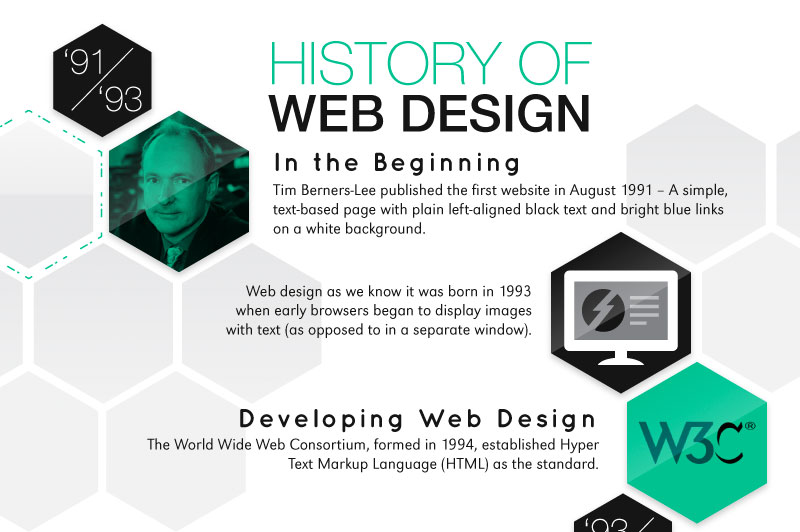Get Ready To Trip Via Time And Find Exactly How Internet Sites Have Actually Become Much More Sophisticated, Easy To Use, And Aesthetically Sensational
Get Ready To Trip Via Time And Find Exactly How Internet Sites Have Actually Become Much More Sophisticated, Easy To Use, And Aesthetically Sensational
Blog Article
Content Produce By-Thorsen Clarke
In the past, internet sites were basic and concentrated on information. Navigation was straight, and design was for desktop computers. Currently, user experience is essential. Data guides designs for very easy navigating. Receptive formats suit different tools. Today, dark setting minimizes strain, and minimalist menus boost navigating. Interactive attributes involve customers, and bold visuals stand out. AI integration enhances involvement. See just how layout has progressed to improve your on-line journey.
Early Days of Web Design
In the very early days of website design, simplicity preponderated. Sites were fundamental, with limited colors, typefaces, and designs. The focus was on supplying details rather than showy visuals. Individuals accessed the internet with slow-moving dial-up links, so rate and capability were essential.
Navigation menus were straightforward, typically situated on top or side of the page. Websites were developed for home computer, as mobile surfing had not been yet common. https://www.crn.com/news/running-your-business/cisco-channel-leader-michelle-ragusa-mcbain-5-marketing-tips-for-smb-focused-msps was king, and designers prioritized very easy readability over complicated layout aspects.
HTML was the key coding language used, and designers had to function within its restraints. Animations and interactive features were very little compared to today's requirements. Internet sites were fixed, with little dynamic material or customized individual experiences.
Rise of User-Focused Style
With the evolution of site layout, a change towards user-focused layout concepts has actually ended up being progressively famous. Today, producing sites that focus on customer experience is essential for involving site visitors and attaining organization objectives. User-focused design includes comprehending the demands, preferences, and actions of your target market to customize the web site's layout, material, and includes appropriately.
Developers currently carry out detailed research, such as customer surveys and use screening, to gather insights and responses straight from users. This data-driven strategy assists in developing intuitive navigation, clear calls-to-action, and visually attractive user interfaces that reverberate with site visitors. By putting the individual at the center of the style process, internet sites can deliver a much more personalized and enjoyable experience.
Responsive layout has actually also become a crucial element of user-focused style, ensuring that websites are maximized for various devices and screen sizes. This flexibility improves ease of access and usability, satisfying the varied methods users communicate with web sites today. Essentially, the increase of user-focused layout signifies a shift in the direction of creating electronic experiences that focus on the needs and expectations of completion user.
Modern Trends in Web Design
Discover the latest patterns forming web design today. One famous fad is dark setting layout, using a smooth and modern look while reducing eye pressure in low-light settings. Another crucial trend is minimalist navigation, simplifying menus and improving user experience by concentrating on essential elements. Integrating micro-interactions, such as animated buttons or scrolling results, can create a much more interesting and interactive web site. Responsive layout stays critical, guaranteeing smooth customer experiences across different gadgets. In addition, utilizing vibrant typography and unbalanced layouts can add visual interest and draw attention to details content.
Incorporating AI technology, like chatbots for client assistance or personalized recommendations, enhances customer interaction and streamlines processes. Ease of access has likewise become a substantial pattern, with designers focusing on comprehensive design practices to accommodate varied customer needs. Accepting sustainability by optimizing internet site performance for speed and efficiency is an additional arising fad in web design. Working together with individual feedback and information analytics to repeat and boost design constantly is essential for staying pertinent in the ever-evolving electronic landscape. By embracing these modern-day patterns, you can create a visually attractive, straightforward site that reverberates with your audience.
Final thought
As you review the development of web site style from the very early days to currently, you can see exactly how user-focused layout has ended up being the driving force behind contemporary fads.
Accept the journey of modification and adaptation in web design, always maintaining the user experience at the forefront.
Keep current with the current fads and innovations, and never stop advancing your method to create visually magnificent and straightforward web sites.
Evolve, adapt, and create - the future of web design remains in your hands.
